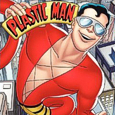King Features Syndicate/Paramount Pictures Corporation (1962-1964), BCI (November 6, 2007), 2 discs, 390 mins plus supplements, original full frame ratio, Dolby Digital 2.0 Mono, Not Rated, Retail: $14.98
Storyboard:
Lazy army private Beetle Bailey joins his friends in making life difficult for Sergeant Snorkel and General Halftrack at the army base Camp Swampy.
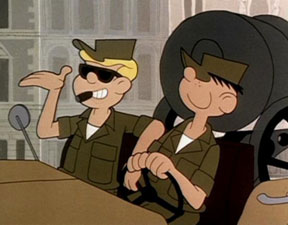
The Sweatbox Review:
I love scoping out comic strip adaptations— it’s always so interesting to me to see how the adaptation is done. The best often make for classic cartoons, while even the least successful outcomes often include the most fascinating choices. Comic strips have been such an obvious source for animated cartoons that some of the earliest animations were derived from then-current comic strip characters. Cartoon buffs know about the great Winsor McCay’s Little Nemo In Slumberland, and of course there has been everything from Popeye to Boondocks; but how many people remember that the perennially popular Beetle Bailey once starred in his own theatrical and television series? Not bad for a lazy army private. Even Little Orphan Annie and Buck Rogers never got their own cartoons!
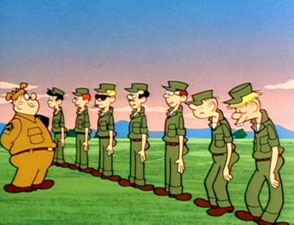
Good ol’ Beetle got his start in countless cartoons done by creator Mort Walker for a variety of magazines in the 1940s. He was a little different back then, just as apathetic as ever but going to college and sporting the name “Spider”. When Walker switched gears and turned his one-panel cartoons into a strip, he sold it to King Features Syndicate, who had a suggestion: rename the character “Beetle”. Less than a year later, Walker had Beetle quit college and hook up with the U.S. Army. Beetle was stationed at Camp Swampy, where he drove the officers crazy. A fat but dedicated officer named Sergeant Snorkel, as well as semi-witless base commander General Halftrack, endured the worst of it, although junior officer Lieutenant Peachfuzz also became a prime foil. It would have been easier on all of them if Beetle didn’t have so many friends with questionable motivation, including the overly sly and hip Cosmo, a skirt-chaser named Killer, the erudite Plato, and the yokel Zero. Together, they made for a fun group of guys, but certainly not the folks you would want protecting your country. Beetle Bailey’s circulation grew to huge numbers, becoming one of the most popular strips in the world, and now appears in roughly 1800 papers. With numbers like that, one can see that creating an animated series made perfect sense.
Enter Paramount Cartoon Studios, the former Famous Studios, an animation studio that had sold off most of its own characters (like Casper The Friendly Ghost) to Harvey Comics in the late 1950s, and had seen its new attempts at creating cartoon stars fail fairly miserably. In the early 1960s, they arranged with King Features to have a “Comic Kings” series of cartoons that would include Krazy Kat, Snuffy Smith (And Barney Google), and Beetle Bailey. Beetle’s first cartoon debuted in theatres in 1962. Home Sweet Swampy saw Beetle ordered to take a reluctant Sarge into the city for some R & R. The humor came from seeing Snorkel fight all attempts to get him to relax, as he tried to get back to his beloved Camp Swampy. It was an interesting choice for a starting entry, given that so much of the cartoon features the characters out of uniform and away from the base. Nevertheless, it was the start of a modest series of five Beetle Bailey cartoons that came out under the “Comic Kings” banner. They were generally professionally done shorts, given that they were all directed by long-time Famous man Seymour Kneitel, though they lacked the polish of cartoons from a decade ago.
These same cartoons were also meant to be part of a television package done for executive producer Al Brodax. A total of 50 Beetle Bailey cartoons were wanted, all to be done at Famous Studios. Krazy Kat and Snuffy Smith also got a total of 50 cartoons, with all three series to appear in the television program King Features Trilogy. It was at the same time that 212 Popeye cartoons had their workload shared between a few other studios in order to form a new Popeye program for King Features. Later on, the various King Features cartoons were again grouped together for a syndicated Beetle Bailey And Friends program.
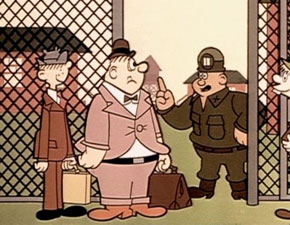
This DVD set from BCI therefore contains all 50 of the Beetle Bailey shorts done for King Features Trilogy, which includes the five theatrical ones (Home Sweet Swampy, Hero’s Reward, Psychological Testing, Et Tu Otto, and A Tree Is A Tree Is A Tree?). Oddly, the theatricals appear only as the main parts of the final two of thirteen “episodes” in this two-disc set, rather than in the beginning. Each of the first eleven “episodes” on the discs simply group together four of the television cartoons, while the last two have three each (the theatricals plus Beetle’s High Horse). It doesn’t really matter too much, though, other than historical interest, as the animation in all of the cartoons is of similar (low) quality and contain no continuity. Kneitel did not direct them all, however, and there are a number of weak ones in the batch (including some of Kneitel’s).
Actually, except for a few gems, these cartoons define mediocrity. The scripts lack cleverness, which you might normally think would force the directors to resort to slapstick, but the limited animation apparently left them uninspired to do so. In fact, very little of what is seen in these cartoons suggests any level of inspiration. Designs are boring, backgrounds are drab, characters wander off-model, and in the end these are clearly the work of a studio cranking out cartoons to meet a quota. The one redeeming feature is that all the cartoons were done by Paramount, so there is at least some quality control, which could not be said of the wildly inconsistent Popeye television cartoons of the same era. Still, the resulting cartoons are amiable enough, and do offer some clean humor.

Many of the cartoons have plots that start with a threat of visiting dignitaries, or have the enlisted men challenged by the officers to complete a task— mostly both, such as when the fellows have to form a band in Don’t Fiddle With The Brass. A couple of shorts (Sgt. Snorkel’s Longest Day, A Christmas Tale) have extended dream sequences. Several shorts include complications concerning Beetle’s girlfriend Honey. The better episodes tend to be those that go a little outside the box, such as Beetle’s farcical date predicament in Bye Bye Young Lovers, or his being branded The Jinx due to a fortune cookie message. This latter one, as well as several more, appeared on an earlier Image Entertainment DVD, which I can now see did a fine job of picking out the very best shorts. It is clear that those ones stand above the others in entertainment value, largely thanks to a greater willingness to play things more broadly, even with a pinch of fantasy added to the mix. Camp Invisible, with Zero’s invisibility paint, and Courage Encourager’s slightly mad scientist are perfect examples of what potential this series had when allowed to breathe and move past boring, simplistic plots. If one simply viewed the very funny Psychological Testing, for example, one would be left with a much better impression than one gets after watching the whole series.
Although this is a generally weak batch of cartoons, I do still hope that we may someday see a Snuffy Smith set (the Krazy Kat cartoons have already seen a release from Koch). I should alert comic strip buffs that Stuffy and Barney Google do appear in a cameo in the Beetle cartoon V Is For Visitor, in a crowd of visitors to Camp Swampy. It is a brief highlight in a cartoon that is about as plain and ordinary as many of the cartoons on this set.

Is This Thing Loaded?
The animated menus make use of a comic strip design, and suggest to the viewer that we will be treated to something a little more special than what we ultimately get.
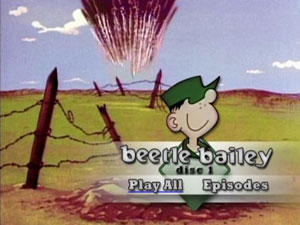
On the other hand, the second disc serves up something that was quite unexpected. Although the packaging makes no mention of any special features, the Episodes menu on the second disc promises a Bonus Episode. It turns out that this is a half-hour Beetle Bailey TV special that was produced in 1989, co-written by Mort Walker and Hank Saroyan. Eighties references make it a product of its time, with mentions of Eighties icons Gaddafi, Stallone, and Schwarzenegger, plus the appearance of an archaic fax machine. Like so many of the sixties cartoons, the promised visit of an Army dignitary sets the plot into motion, as Sarge and Beetle take turns tying to turn each other into the ultimate soldier. While the characters do stay on-model much better this time around, and the backgrounds are a tad more interesting, this is still pretty mediocre stuff. Still, I am impressed they thought to include it, and I’m glad that I had the opportunity to watch it, if for nothing else than enjoying the interesting cast. Henry Corden, the second Fred Flintstone, plays Snorkel, Frank Welker does Zero and Otto, Larry Storch does the general, and Greg Whalen plays Beetle. Although, while they were at it, it would have been really great if they had included the TV specials featuring Beetle’s sister Lois, from the Hi & Lois comic strip. (Yes, it’s true! Lois was introduced in Beetle Bailey in 1954.)

Case Study:
Now, I haven’t seen one of these for a while! BCI packages Beetle in a double-thick keepcase, the like of which has generally been replaced with slimmer alternatives. Contrary to the usual BCI standards, there was no insert included in my copy, but the contents (except for the Bonus Episode) are listed on the back of both the case and the sturdy slipcase, which has the same front cover but a different back cover than the case. One cartoon has its name spelled wrong, appearing as Beetle’s High Horps, instead of Horse. Sloppy, guys.
I was quite surprised to note the absence of the “Ink & Paint” logo on the box, as previous King Features sets from BCI have fallen under that banner, starting with Flash Gordon and The Legend Of Prince Valiant; but the Ink & Paint video logo does play on the discs themselves.
Ink And Paint:
You won’t be bragging on your home theater set-up with this DVD set. Aside from the drab, drab colors (at least partially the fault of the original design of the show), the materials used for the transfers are only in fair shape. The cartoons are very watchable, but do show off a variety of scratches and other signs of wear. The transfer for the Bonus Episode is a little better, but still sports a somewhat soft, faded, and dirty transfer. At least no compression artifacts are present, but there are instances of visible edge enhancement.

Scratch Tracks:
Monaural sound is split across two channels in a presentation every bit as drab as the video. Voices and sound effects are a little squawky, but certainly in keeping with what one would expect out of a cheap 1960s cartoon show. Voice talent is certainly recognizable, at least. Howard Morris, recently heard as “Jughead” in the Archie Show DVD set, plays Beetle Bailey in much the same voice. He also does General Halftrack in the same whistle-sprinkled voice he did as “Gopher” in Disney’s Winnie The Pooh theatrical featurettes. Allen Melvin (often heard on Hanna-Barbera cartoons, including the title character on Magilla Gorilla) plays Sergeant Snorkel. I could also hear June Foray on occasion (e.g. the cartoon The Play’s The Thing, as both Hungarian actress Zaza Vavoom, sounding very “Natasha Fatale,” and Beetle’s jealous girlfriend Bunny).
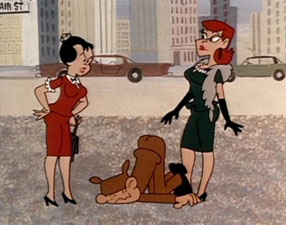
The music on the cartoons is as unremarkable as anything else in these shorts, but the series does boast the likes of George Bruns and Winston Sharples providing arrangements.
Final Cut:
As a piece of Paramount cartoon history, this is a neat little collectible. As entertainment, it serves little more value than research material for those desperately interested in anything surrounding the Beetle Bailey comic strip. The best episodes were already available on a previous DVD, which also featured a great Hagar The Horrible TV special as well as a neat Fleischer-eque Betty Boop one. I’d recommend that particular disc over this set, unless you are really curious about the 1989 Beetle TV special. The cartoons here are just so… ordinary. With no other extras present, this is the slimmest of BCI’s Ink & Paint line to date and in combination with a weak program offers less collectibility for those outside of specialty collectors.
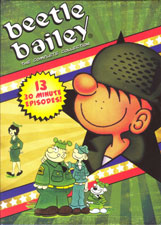 | ||
 |








